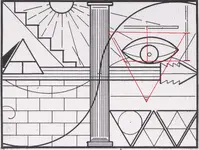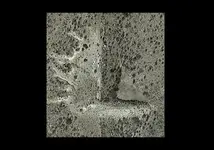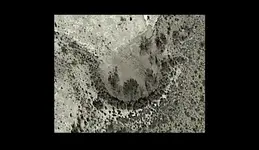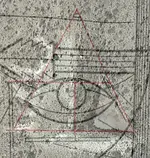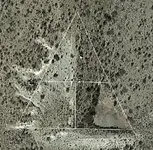Hi. I for one, am not familiar with these stories. I would really enjoy any details your able to share.
As I wrote, IMO the LUE map is a Spanish treasure map. Few things about Spanish treasure maps that you have to know:
- Spanish treasure maps are depicting always lines and shapes on the ground, following rows of rocks, boulders and profiles of mountain/hill tops. They never use a canyon or a river's course, so what you see to looks like a canyon or a river, are just lines which connect rocks and boulders each other. The name of a river reveals it's location only on the specific spot written on the map.
- Spanish treasure maps could be oriented to a true cardinal direction ( E-W-N-S ), but also can be oriented to a magnetic declination of the era the map was made, or to use encrypted codes written on the map in regards to the orientation. Usually for codes they used few "X" beside the word of a direction. If the X's are alone, they should be read in regards to the true north, to the east or to the west considering on which side of the map are written.
- Every Spanish treasure map is unique, and the map maker use his own inspiration and choose his own " lines " from the region in regards to make the map. It's like a fingerprint for every Spanish map maker, and for this, there exist some maps of the same area, which are totaly different, with different concept and inspiration. Because every Spanish map is unique, usually the map maker write a coded letter with instructions of the route to the region, coded distances from a specific spot, or an exact oral explanation of the codes if the map is given directly to the interested person. So without the instructions of a Spanish map, someone who is very skilled and familiar with Spanish maps readings, could decrypt from 0 ( zero ) to 100% , depending of what clues are written on the map.
- Spanish treasure maps were made using a real image of the region, but also have been made in a mirrored image of the region, half real - half up side down, or using two or mare real images in the same map which are for different regions at different scales, or using two or more real images for the same region at different scales.
- The Spanish treasure maps were made very meticously and very accurately to the region they represent. If the lines from the map doesn't match the lines from the region, then the map it's fake or it'a a bad reproduction. Look for the original map in regards to have the real clues.
- The Spanish treasure maps pattern and the codes used in them , were " borrowed " by the Mexicans and the Jesuits maps makers. Also the Mormons were familiar with the Spanish treasure maps readings, and in some cases they made few maps using the same pattern.
Now about the LUE map. This map is a Spanish treasure map made half real - half up side down. The map maker use as extra codes except the lines which depict shapes on the ground, the rising sun and the small circle in bigger circle which is a symbol for a mine/shaft.
The wall with the wave on it , depicted on the half real image, tells us about a structure like a dam, which is located easterly on a side of a range with many peaks. The location of the triangle, which is given as a key to be able to find the mine on the other half up side down side of the map, show us it's not attached to the dam but little above, and the vertical line which cuts the triangle in half, starts at about a fifth of the dam's lenght from the left. The rays of the rising sun are not touching the triangle, so this means how the real image from the left of the map, is giving us only info about where the triangle is located in regards to the dam.
Now, turn the map up side down flipping it around, and we have the left half side of the map which shows were is the mine in regards to the triangle we will draw connecting the short lines depicted on the map, using as the peak of the triangle, the small triangle above the mine. I connected those lines for you in regards to see the shape of the triangle which has been created. The two lines below the triangle are the top of the dam, so we have the triangle at the location which was shown in the first map. Also the rays of the rising sun are touching the triangle so we are on the easterly side of the range looking to the west. From what you have understood, the map as you are looking at it in the first place, has orientation to the true east.
Now, search for the line which cuts the triangle, at a tenth of the dams lenght from the left, and search from the other lines in regards to create the triangle on the ground. While you have finished to create the triangle on the ground , go to the spot of the small cicle and you will find the spot of the mine.
Something about the name of the map, LUE. After doing my research , I came to the conclusion the map maker used the shapes of the two dams they made in the region, and the letter " E " which is for the Spanish word " ESTE " ( east ). Those dams are hand made by scraching the soil around them, but for the " L " dam I believe they used and tailings from the mine, because is bigger and higher than the " U " dam. I will post aerial images of the dams. Maybe the dams were made to provide water for their livestock and for another pourposes. Also the half initial side of the map ( that with the east on top ), prompts us to use the " L " dam, and this could be concluded from the wall which is not curved and if you remove the arrow from the lines which go to the right, the half middle column with the rest of the lines to the right without the arrow, resembles an " L ".
Now, I will post the map with the invisible triangle drewn, and the aerial images of the dams, and how the invisible triangle on the map fits to the region of the dam, and the lines of the invisible triangle in regards to the " L " dam. I hope in the last image to distinguish the small circle at the spot is depicted on the map.
Enjoy and have a nice weekend



